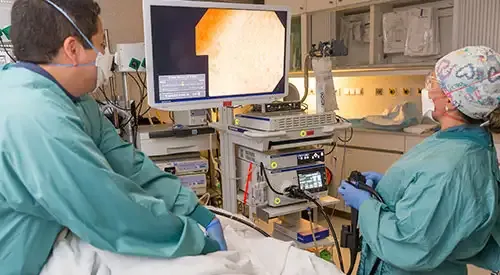Eosinophilic esophagitis

What is eosinophilic esophagitis?
Eosinophilic esophagitis is a disease that causes chronic inflammation of the esophagus, the tube that connects the mouth to the stomach.
This inflammation is caused by an increase in the number of eosinophils, a type of white blood cell, in the esophageal mucosa.
The most common symptoms include difficulty swallowing, chest pain, regurgitation, vomiting, heartburn, weight loss, anemia, chronic cough and abdominal pain.
Diagnosis is made by a combination of medical history evaluation, laboratory tests to measure eosinophil levels and food allergies, and endoscopy with biopsy to confirm the presence of eosinophils in the esophageal mucosa.

What are the symptoms of eosinophilic esophagitis?
Inflammation of the esophagus can make it difficult to pass food, leading to swallowing difficulties, known as dysphagia. This can be especially problematic when swallowing solid foods.
Chest pain
Chest pain is another common symptom of eosinophilic esophagitis. Often, this pain can be mistaken for the pain of a heart attack, making it especially important to seek medical attention for a proper diagnosis.
Other symptoms
Some of the additional symptoms of eosinophilic esophagitis may include regurgitation, vomiting, heartburn, weight loss, anemia, chronic cough, and abdominal pain.
The most common symptoms are:
- Muscle contractures.
- Deviation of the shoulders, back and hips.
- Back pain.
Do you have any of these symptoms?
You may have eosinophilic esophagitis
Causes of eosinophilic esophagitis
Genetic factors
Eosinophilic esophagitis is believed to have a genetic component, which means that people with a family history of the disease are at increased risk.
Food allergies
Food allergies are one of the main causes of eosinophilic esophagitis. Some common foods that can cause allergies include milk, eggs, wheat, soy, nuts and shellfish.
Other causes
There are also other medical conditions and environmental factors that can increase the risk of developing eosinophilic esophagitis, such as gastroesophageal reflux, asthma and parasitic infections.
Complications
If not properly treated, eosinophilic esophagitis can lead to complications such as esophageal narrowing, esophageal ulcers, food impaction and, in rare cases, esophageal perforation.Prevention of eosinophilic esophagitis
Although there is no guaranteed prevention for eosinophilic esophagitis, maintaining a healthy diet and avoiding foods known to trigger allergies may reduce the risk of developing the disease.How is eosinophilic esophagitis diagnosed?

The physician will begin by evaluating the patient's medical history, asking about symptoms and family history of similar diseases.
Blood tests may be performed to measure levels of eosinophils and other inflammatory markers, as well as skin and blood tests to identify possible food allergies.
The definitive diagnosis of eosinophilic esophagitis is made by endoscopy, in which a thin tube with a camera is inserted into the esophagus. During the endoscopy, tissue samples (biopsies) are taken to examine for the presence of eosinophils and other abnormalities.
How is eosinophilic esophagitis treated?
Dietary changes
One of the cornerstones of treatment for eosinophilic esophagitis is dietary modification to eliminate allergy-provoking foods. Patients can work with a nutritionist to develop an appropriate eating plan.
Medications
Physicians may prescribe medications such as corticosteroids, antihistamines and acid blockers to reduce inflammation and control symptoms.
Dilation therapy
In more severe cases, when inflammation has caused narrowing of the esophagus, dilation therapy may be necessary. This involves widening the esophagus using an endoscope equipped with a special balloon.
Where do we treat it?
IN NAVARRE AND MADRID
The Department of Digestive
of the Clínica Universidad de Navarra
The Digestive Department of the Clinica Universidad de Navarra is composed of a multidisciplinary team of specialists who are experts in the diagnosis and treatment of diseases of the digestive tract.
Our objective is that each diagnosis be carefully established and the treatment plan adjusted to each patient.

Why at the Clinica?
- Medical specialists who are national references.
- Specialized nursing team.
- Endoscopy Unit and High Risk Digestive Tumor Prevention and Consultation Unit to offer the best care to our patients.
Our team of professionals
Preguntas frecuentes
The best diet for eosinophilic esophagitis is an elimination diet, which involves avoiding foods that may trigger or aggravate the symptoms of this disease. It is important to keep in mind that each person may react differently to certain foods, so the diet should be personalized and tailored to the patient's specific needs.
To establish the appropriate diet, it is essential to work with a physician and a nutritionist specialized in food allergies. Some of the most common foods that can cause eosinophilic esophagitis include:
- Dairy: milk, cheese, yogurt and other milk products.
- Eggs.
- Soy: soy products such as tofu, soy milk and other soy-containing foods.
- Wheat: bread, pasta, cereals and other foods containing gluten.
- Nuts: almonds, walnuts, peanuts, etc.
- Seafood: shrimp, crabs, lobsters and other shellfish.
- Fish: especially those with bones.
Once the trigger foods have been identified, they should be eliminated from the patient's diet.
Subsequently, they can be gradually reintroduced under medical supervision to determine whether the patient has developed tolerance to these foods. In addition, it is essential to ensure a balanced and nutritious diet, which provides the patient with all the essential nutrients to maintain good health.















